Managing Editor Tabs
Every time you open a file for editing, a dedicated tab is added to the editor window, next to the active editor tab.
PyCharm can limit the number of tabs opened in the editor simultaneously. When the number of tabs reaches its limit, the editor closes the tabs according to the tab closing policy, that is defined in the page of PyCharm settings (Ctrl+Alt+S) By default, the tab limit is 10, but you can change it if necessary.
All commands, related to managing editor tabs, are available from :
menu.
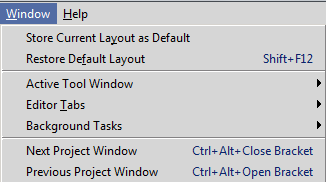
Context menu of a tab.
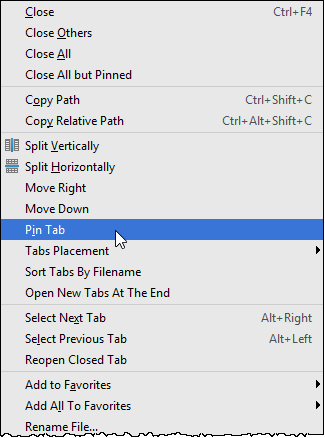
To configure the behavior of editor tabs
In the Settings/Preferences dialog (Ctrl+Alt+S), click General under Editor, and then click Editor Tabs. The Editor Tabs page opens.
Change the maximum allowed number of tabs: type the desired maximum allowed number of the editor tabs to be opened at a time in the Tab limit field.
If the tab limit equals 1, the tabs will be disabled. If you want the editor to never close the tabs, type some unreachable number.
With the disabled tabs, use the (Ctrl+E) command to quickly switch between files.By default, the tab headers appear on top of the editor, but you can change their location as required, and have the headers at the bottom, left, or right sides of the editor. Note that the tab header placement is a global setting that applies to all projects.
Use the Placement selector to choose the desired position of tab headers.
To disable editor tabs altogether, select None from the Placement selector.
Navigating between editor tabs
To navigate from the current tab to the next or previous tab
This approach allows jumping from one tab to another as your editing session requires. While you move between the editor tabs, PyCharm remembers the caret position within each opened file.
Right-click the current editor tab and choose from the context menu.
Press Alt+Right or Alt+Left. So doing, the focus moves to the editor tab located next to the right or to the left from the active editor tab.
Press Ctrl+Tab to use the Switcher.
To go back and forth through the history of visited tabs
This approach enables you to move back and forth through the history of your navigation, same way as it is done in a Web browser. As you move from file to file during your editing session, PyCharm keeps track of the visited locations and enables you to go back, using the commands.
On the main toolbar, click
 or
or  .
. Choose from the main menu.
Press Ctrl+Alt+Left or Ctrl+Alt+Right.
To view all editor tabs and select the active editor
If all opened tabs are shown in a single row, some of the tabs may become invisible. PyCharm helps display the list of the opened editor tabs that did not fit in the editor window and have become invisible whereupon you can choose the tab to activate.
- Do one of the following:
Choose from the main menu.
Click

The list of all the tabs that are opened but invisible appears. So doing the names of the tabs, which are currently visible, are displayed on the light background; the names of the tabs outside of the main window are shown on the darker background.
- Click the name of the desired editor tab:

The selected editor tab becomes active and gets the focus.
The command Show All Tabs and the icon ![]() are only available when:
are only available when:
The Show tabs in single row checkbox is selected in the page of PyCharm settings (Ctrl+Alt+S).
Some of the opened tabs are not visible because they do not fit in the editor window.
Pinning and unpinning tabs
When the specified tab limit is reached, PyCharm will close old tabs when you open new documents. To prevent a tab from being closed automatically, you can pin this tab. Besides, when you close the editor tabs, you have an option to leave pinned tabs opened and close only the unpinned tabs.
When a tab is pinned, there is a special marker on it:

To pin or unpin a tab, right-click on it and choose or from the context menu.
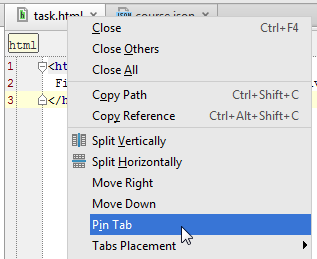
Splitting and unsplitting editor window
Splitting the editor window divides it into independent panes. You can split the editor window into as many panes as required, each one containing multiple tabs.
Each pane can be allocated vertically or horizontally. Thus, splitting helps create different editor layouts and organize tabs into groups. For example, you can scroll through a part of a file, having at the same time the possibility to view the lines in its other part.
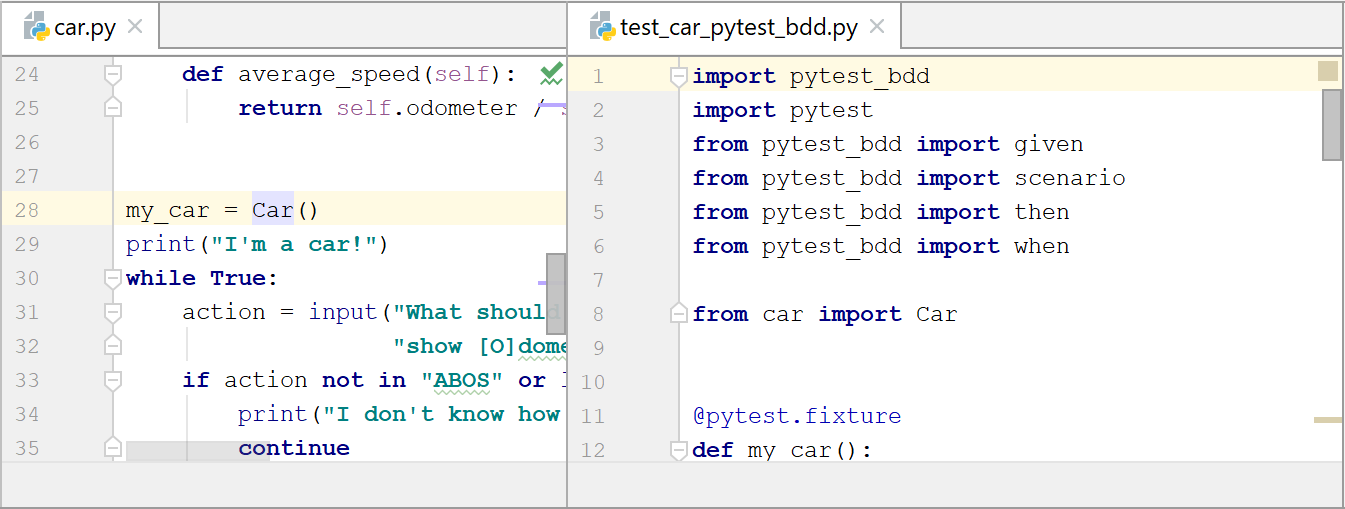
To split and unsplit the editor window
Switch to the desired tab and right-click on it.
To split an editor tab creating a file copy, choose or from the context menu.
To split an editor tab without copying a file, choose or from the context menu.
To change the splitter orientation, choose from the context menu.
- To remove the splitter, choose one of the following commands from the context menu:
To remove splitting in the active tab, choose .
To remove splitting in all the open editor tabs, choose .
Detaching editor tabs
You can detach editor tabs, and move them to separate frames. The detached editor tabs can be split or unsplit, and you can move editor tabs between split panes.
To detach an editor tab, do one of the following:
Drag this tab outside of the main window. You can also use Alt+mouse. A preview thumbnail appears:
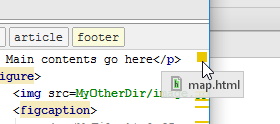
Press Shift+F4.
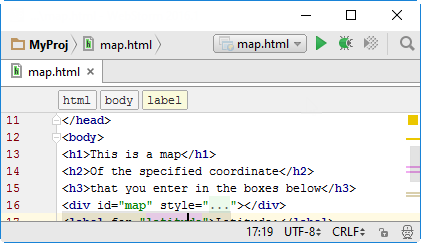
The content of the editor tab opens in a separate frame.
To attach an editor tab, drag it from its frame and drop to the main PyCharm frame until the tab name appears:

Arranging tabs in the alphabetical order
The alphabetical sorting of the editor tabs is available regardless of the tabs position. However, alphabetical order for top and bottom placement becomes available, when the Show tabs in single row check command is selected on the menu.
To sort editor tabs alphabetically
Right-click an editor tab.
- Select .
If this check command is selected, the tabs headers are presented in alphabetical order. Otherwise, the editor tab headers appear in the opening order of the corresponding files.